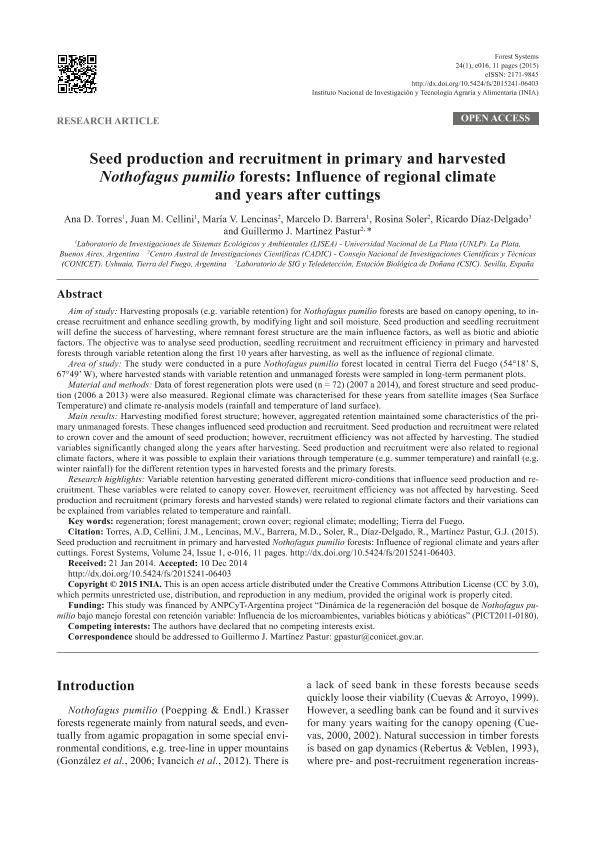Mostrar el registro sencillo del ítem
dc.contributor.author
Torres, Ana Delia
dc.contributor.author
Cellini, Juan Manuel
dc.contributor.author
Lencinas, María Vanessa

dc.contributor.author
Barrera, Marcelo Daniel
dc.contributor.author
Soler Esteban, Rosina Matilde

dc.contributor.author
Díaz Delgado, Ricardo
dc.contributor.author
Martínez Pastur, Guillermo José

dc.date.available
2016-05-06T20:42:45Z
dc.date.issued
2015-03
dc.identifier.citation
Torres, Ana Delia; Cellini, Juan Manuel; Lencinas, María Vanessa; Barrera, Marcelo Daniel; Soler Esteban, Rosina Matilde; et al.; Seed production and recruitment in primary and harvested Nothofagus pumilio forests: Influence of regional climate and years after cuttings; Instituto Nacional de Investigación y Tecnología Agraria y Alimentaria; Forest Systems; 24; 1; 3-2015; 1-11
dc.identifier.uri
http://hdl.handle.net/11336/5563
dc.description.abstract
Aim of study: Harvesting proposals (e.g. variable retention) for Nothofagus pumilio forests are based on canopy opening, to increase recruitment and enhance seedling growth, by modifying light and soil moisture. Seed production and seedling recruitment will define the success of harvesting, where remnant forest structure are the main influence factors, as well as biotic and abiotic factors. The objective was to analyse seed production, seedling recruitment and recruitment efficiency in primary and harvested forests through variable retention along the first 10 years after harvesting, as well as the influence of regional climate. Area of study: The study were conducted in a pure Nothofagus pumilio forest located in central Tierra del Fuego (54º18? S, 67º49? W), where harvested stands with variable retention and unmanaged forests were sampled in long-term permanent plots. Material and methods: Data of forest regeneration plots were used (n=72) (2007 a 2014), and forest structure and seed production (2006 a 2013) were also measured. Regional climate was characterised for these years from satellite images (Sea Surface Temperature) and climate re-analysis models (rainfall and temperature of land surface). Main results: Harvesting modified forest structure; however, aggregated retention maintained some characteristics of the primary unmanaged forests. These changes influenced seed production and recruitment. Seed production and recruitment were related to crown cover and the amount of seed production; however, recruitment efficiency was not affected by harvesting. The studied variables significantly changed along the years after harvesting. Seed production and recruitment were also related to regional climate factors, where it was possible to explain their variations through temperature (e.g. summer temperature) and rainfall (e.g. winter rainfall) for the different retention types in harvested forests and the primary forests. Research highlights: Variable retention harvesting generated different micro-conditions that influence seed production and recruitment. These variables were related to canopy cover. However, recruitment efficiency was not affected by harvesting. Seed production and recruitment (primary forests and harvested stands) were related to regional climate factors and their variations can be explained from variables related to temperature and rainfall.
dc.format
application/pdf
dc.language.iso
eng
dc.publisher
Instituto Nacional de Investigación y Tecnología Agraria y Alimentaria
dc.rights
info:eu-repo/semantics/openAccess
dc.rights.uri
https://creativecommons.org/licenses/by-nc-sa/2.5/ar/
dc.subject
Regeneration
dc.subject
Forest Management
dc.subject
Crown Cover
dc.subject
Regional Climate
dc.subject
Modelling
dc.subject
Tierra del Fuego
dc.subject.classification
Silvicultura

dc.subject.classification
Agricultura, Silvicultura y Pesca

dc.subject.classification
CIENCIAS AGRÍCOLAS

dc.title
Seed production and recruitment in primary and harvested Nothofagus pumilio forests: Influence of regional climate and years after cuttings
dc.type
info:eu-repo/semantics/article
dc.type
info:ar-repo/semantics/artículo
dc.type
info:eu-repo/semantics/publishedVersion
dc.date.updated
2016-04-01T17:26:25Z
dc.identifier.eissn
2171-9845
dc.journal.volume
24
dc.journal.number
1
dc.journal.pagination
1-11
dc.journal.pais
España

dc.journal.ciudad
Madrid
dc.description.fil
Fil: Torres, Ana Delia. Universidad Nacional de la Plata. Facultad de Ciencias Agrarias y Forestales. Laboratorio de Investigacion de Sistemas Ecologicos y Ambientales; Argentina
dc.description.fil
Fil: Cellini, Juan Manuel. Universidad Nacional de la Plata. Facultad de Ciencias Naturales y Museo. Laboratorio de Investigacion en Sistemas Ecologicos y Ambientales; Argentina
dc.description.fil
Fil: Lencinas, María Vanessa. Consejo Nacional de Investigaciones Científicas y Técnicas. Centro Austral de Investigaciones Científicas; Argentina
dc.description.fil
Fil: Barrera, Marcelo Daniel. Universidad Nacional de la Plata. Facultad de Ciencias Agrarias y Forestales. Laboratorio de Investigacion de Sistemas Ecologicos y Ambientales; Argentina
dc.description.fil
Fil: Soler Esteban, Rosina Matilde. Consejo Nacional de Investigaciones Científicas y Técnicas. Centro Austral de Investigaciones Científicas; Argentina
dc.description.fil
Fil: Díaz Delgado, Ricardo. Consejo Superior de Investigaciones Cientificas. Estación Biológica de Doñana; España
dc.description.fil
Fil: Martínez Pastur, Guillermo José. Universidad Nacional de la Plata. Facultad de Ciencias Agrarias y Forestales. Laboratorio de Investigacion de Sistemas Ecologicos y Ambientales; Argentina
dc.journal.title
Forest Systems
dc.relation.alternativeid
info:eu-repo/semantics/altIdentifier/url/http://revistas.inia.es/index.php/fs/article/view/6403/2315
dc.relation.alternativeid
info:eu-repo/semantics/altIdentifier/url/http://digital.csic.es/handle/10261/117122
Archivos asociados
